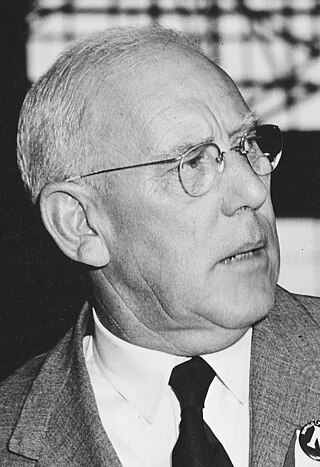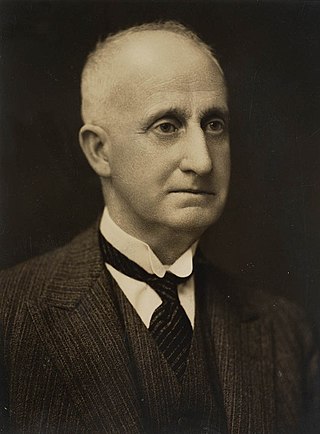
Air Vice-Marshal Sir Philip Woolcott Game, was a Royal Air Force commander, who later served as Governor of New South Wales and Commissioner of Police of the Metropolis (London). Born in Surrey in 1876, Game was educated at Charterhouse School and entered the military at Royal Military Academy Woolwich, gaining his commission in 1895. Serving with the Royal Artillery, Game saw action in the Second Boer War and the First World War. After serving with distinction and bravery, Game transferred to the Royal Flying Corps in early 1916 serving as General Trenchard's chief staff officer. Finishing the War as an acting major-general, Game remained in the Royal Air Force after the close of hostilities. Notably he served as Air Officer Commanding RAF India and Air Member for Personnel. He retired from the military in 1929, having reached the rank of air vice-marshal.
Section 51(i) of the Australian Constitution enables the Parliament of Australia to make laws about:

Robert James Heffron, also known as Bob Heffron or R. J. Heffron, was a long-serving New South Wales politician, union organiser and Labor Party Premier of New South Wales from 1959 to 1964. Born in New Zealand, Heffron became involved in various Socialist and labour movements in New Zealand and later Australia before joining the Australian Labor Party. A prominent unionist organiser, we was gaoled for "conspiracy to strike action". He was later elected to the Parliament of New South Wales for Botany in 1930. However his disputes with party leader Jack Lang led to his expulsion from the ALP in 1936 and Heffron formed his own party from disgruntled Labor MPs known as the Industrial Labor Party. The success of his party enabled his readmission to the party and his prominence in a post-Lang NSW Branch which won office in 1941.

Albert Bathurst Piddington KC was an Australian lawyer, politician and judge. He was a member of the High Court of Australia for one month in 1913, making him the shortest-serving judge in the court's history.
Members of the New South Wales Legislative Council who served in the 49th Parliament were elected at the 1981, 1984 and 1988 elections. Members served for three terms of the Legislative Assembly, which, as a result of the 1981 referendum meant the maximum term was twelve years. The 15 members elected in 1981 did not face re-election until 1992, the 15 members elected in 1984 did not face re-election until 1996 and the 15 members elected in 1988 did not face re-election until 2000. The terms of members were cut short by the 1991 referendum which reduced the term to two terms of the Legislative Assembly, a maximum of 8 years. The President was Johno Johnson.
Abram Landa was an Australian politician and a member of the New South Wales Legislative Assembly from 1930 until 1932 and from 1941 until 1965. He was variously a member of the Australian Labor Party (NSW) and the Australian Labor Party. He held a number of ministerial positions between 1953 and 1965.

The 1950 New South Wales state election was held on 17 June 1950. It was conducted in single member constituencies with compulsory preferential voting and was held on boundaries created at a 1949 redistribution. The election was for all of the 94 seats in the Legislative Assembly, which was an increase of 4 seats since the previous election.

The 1962 New South Wales state election was held on 3 March 1962. It was conducted in single member constituencies with compulsory preferential voting and was held on boundaries created at a 1961 redistribution. The election was for all of the 94 seats in the Legislative Assembly.

Charles Edward Chubb was a judge in the Supreme Court of Queensland, Australia. He was also a Member of the Queensland Legislative Assembly and an Attorney-General of Queensland.

The Lang ministry (1930–1932) or Third Lang ministry was the 45th ministry of the New South Wales Government, and was led by the 23rd Premier, Jack Lang. This ministry was the third and final time of three occasions where Lang was Premier.

Robert Reginald Downing, was an Australian lawyer, textile worker, union organiser and politician. He was a member of the New South Wales Legislative Council for the Labor Party for 31 years from 1940 to 1972 and also served as the Attorney General, Minister for Justice and Vice-President of the Executive Council from 1941 to 1965.

The Heffron ministry (1959–1962) or First Heffron ministry was the 59th ministry of the New South Wales Government, and was led by the 30th Premier, Bob Heffron, of the Labor Party. The ministry was the first of two consecutive occasions when the Government was led by Heffron, as Premier.

Sir John Beverley Peden was an Australian jurist and politician. Born in Randwick to farmer Magnus Jackson Peden, a mayor of Randwick, and Elizabeth Neathway Brown, he attended public school at Bega before studying at Sydney Grammar School and the University of Sydney, where he received a Bachelor of Arts in 1892 and a Bachelor of Laws in 1898. He was an assistant lecturer in Latin at the university from 1896 to 1898, when he was called to the bar. He lectured in law from 1903 and became a professor and faculty dean in 1910. Appointed to the New South Wales Legislative Council as a Nationalist in 1917, from 1929 to 1946 he was president of the council; he was both the last president appointed directly by the governor, and the first elected by his fellow councillors. Peden died in Paddington in 1946.
Members of the New South Wales Legislative Council who served from 1930 to 1932 were appointed for life by the Governor on the advice of the Premier. This list includes members between the 1930 state election on 25 October 1930 and the 1932 state election on 11 June 1932. The President was Sir John Peden. The Premier Jack Lang had been seeking to swamp the council, however the Governor Sir Philip Game had declined to do so in November 1930, March, June and September 1931 when Lang sought 70 new members be appointed. In November 1931 Lang dropped his request to 25 new members and the governor agreed to the request. This raised the number of members of the council from 85 to 110.
Members of the New South Wales Legislative Council who served from 1925 to 1927 were appointed for life by the Governor on the advice of the Premier. This list includes members between the 1925 state election on 30 May 1925 and the 1927 state election on 8 October 1927. The President was Fred Flowers. The Labor platform included the abolition of the Legislative Council. At the opening of the new parliament on 24 June 1925 there were 75 members of the council, with just 23 Labor members and Premier Jack Lang had been seeking to appoint 25 new members, however the Governor Sir Dudley de Chair had declined to do so in September 1925. In December the Governor agreed to make the appointments in circumstances that are disputed. De Chair understood there was an agreement that the appointments would not be used to abolish the Legislative Council, while Lang said he gave no such undertaking. All 25 appointees took the pledge to implement the Labor platform, "including the abolition of the Legislative Council", similar to that signed by other Labor members.

Deakin v Webb was one of a series of cases concerning whether the States could tax the income of a Commonwealth officer. The High Court of Australia overruled a decision of the Supreme Court of Victoria, holding that the States could not tax the income of a Commonwealth officer. This resulted in conflict with the Privy Council that was ultimately resolved by the passage of Commonwealth law in 1907 to permit the States to tax the income of a Commonwealth officer. The constitutional foundation of the decision was overturned by the subsequent decision of the High Court in the 1920 Engineers' Case.

The Constitution Act 1902 is the founding document of the State of New South Wales, and sets out many of the basic principles of the Government of New South Wales. This act created the foundation of the Executive, Legislative and Judicial branches of the Government of New South Wales. Most of the Constitution can be amended through ordinary Acts of Parliament, however some sections can only be amended through a referendum of NSW voters.
The 1978 New South Wales referendum was held on 17 June 1978 and contained a single question:
Do you approve of the Bill entitled 'A Bill for an Act to provide for the election of members of the Legislative Council directly by the people'.
A referendum concerning the reform of the New South Wales Legislative Council was put to New South Wales voters on 13 May 1933 and was passed by the voters with a margin of 2.94%. The text of the question was:
Do you approve of the Bill entitled "A Bill to reform the constitution and alter the Powers of the Legislative Council; to reduce and limit the number of Members of the Legislative Council; to reconstitute the Legislative Council in accordance with the reformed constitution; to amend the Constitution Act, 1902, and certain other Acts; and for purposes connected therewith."
There have been 18 referendums in New South Wales, 8 of which concerned proposals to amend the New South Wales Constitution, half of which concerned the Legislative Council. While the Constitution of Australia was adopted after the 1898 and 1899 referendums in all of the proposed states, the constitution of New South Wales, promulgated in 1902, was an Act of the Parliament of New South Wales which could be amended by parliament. Since 1927 the constitution has included provisions that can only be amended following approval in a referendum. 8 of the referendums, including 5 on the sale of alcohol, did not involve any proposed amendment to the constitution. While these have traditionally been called referendums, they could also be described as plebiscites.









